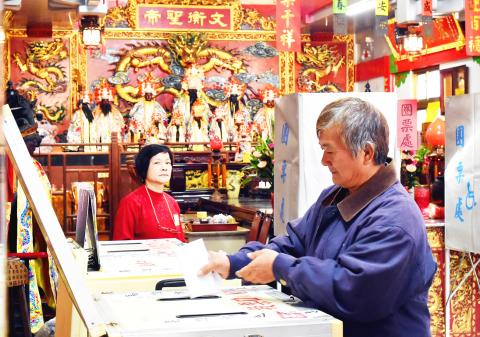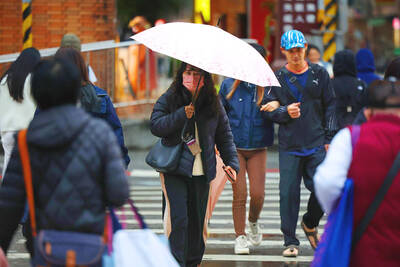The Democratic Progressive Party (DPP) won a legislative majority in yesterday’s election, securing 68 seats in the 113-seat legislature. With its ally the New Power Party (NPP) winning five legislative seats, the DPP is expected to enjoy unrestricted power in the parliament.
Before the elections, the DPP had called on voters to cast their legislative ballots for the party’s candidates to help it secure a majority in the legislature without the NPP’s assistance.
The Chinese Nationalist Party (KMT), which held 64 legislative seats before the election, hoped to secure at least 38 seats to prevent the majority party or alliance to motion for a recall of the president, which can be done with a two-thirds majority in the legislature. The DPP got what it wanted, but not the KMT.

Graphic: Louise Ting, Taipei Times
DPP president-elect Tsai Ing-wen’s (蔡英文) “coattail effect” has helped the party sweep legislative votes.
However, the real force that carried the opposition parties to victory is probably the “awakened youth,” who have been calling for the removal of the KMT from government since 2014’s Sunflower movement.
The NPP, which was established in the movement’s wake, fielded three political novices in the election — a leading activist in the Sunflower movement, a famous metal singer and a victim-turned symbol of nationwide demonstrations against abuse in the military — as its regional legislative candidates. All three got elected, defeating three veteran KMT lawmakers.

Photo: Chang Chung-yi, Taipei Times
However, while the NPP has won representation in the legislature as expected, the 5 percent threshold has proved to be a hurdle for other small parties, such as the Green Party-Social Democratic Party Alliance, the Republican Party and the Faith and Hope League, which are among parties that were established following the Sunflower movement.
The Taiwan Solidarity Union, which had three seats in the 2012 legislature, failed to cross the 5 percent threshold this time. The rise of the NPP was definitely a factor, but its decision to team up with Le Flanc Radical, a Taiwan-independence group consisting of young people, has been considered a move that came too late to garner young votes.
The People First Party’s (PFP) crossing the threshold might be seen as a coattail effect of its party chairman and presidential candidate James Soong (宋楚瑜). It was said that Soong’s bid, which was his third, was a ploy to campaign for party votes. It remains to be seen how the PFP would retain its so-called “non-blue, non-green and middle way” in a pan-green parliament.
The New Party, which received tacit support from Deputy Speaker Hung Hsiu-chu (洪秀柱) of the KMT and other KMT members who were dissatisfied with the party’s at-large legislative candidate list, made gains, winning more than 4 percent of party votes, while having only won 1.49 percent of the votes in 2012.
With the KMT’s rout, the distribution of the political power within the KMT and the pan-blue camp as a whole would be followed closely.
An interesting point raised by commentators is how the forced apology of Korean pop music group member Chou Tzu-yu (周子瑜) affected young voters and the elections’ outcome. It has been said that many young people decided to vote after the incident, in defiance of pressure from China. The DPP’s victory, in terms of its gains in party votes compared with what was expected, is said to be an outcome of the incident.
The KMT had secured 64 seats in a 113-seat legislature in 2012, while the DPP had 40 seats, the Taiwan Solidarity Union and the PFP each had 3, the Non-Partisan Solidarity Union had 2 and independents, 4.

NUMBERS IMBALANCE: More than 4 million Taiwanese have visited China this year, while only about half a million Chinese have visited here Beijing has yet to respond to Taiwan’s requests for negotiation over matters related to the recovery of cross-strait tourism, the Tourism Administration said yesterday. Taiwan’s tourism authority issued the statement after Chinese-language daily the China Times reported yesterday that the government’s policy of banning group tours to China does not stop Taiwanese from visiting the country. As of October, more than 4.2 million had traveled to China this year, exceeding last year. Beijing estimated the number of Taiwanese tourists in China could reach 4.5 million this year. By contrast, only 500,000 Chinese tourists are expected in Taiwan, the report said. The report

Temperatures are forecast to drop steadily as a continental cold air mass moves across Taiwan, with some areas also likely to see heavy rainfall, the Central Weather Administration (CWA) said. From today through early tomorrow, a cold air mass would keep temperatures low across central and northern Taiwan, and the eastern half of Taiwan proper, with isolated brief showers forecast along Keelung’s north coast, Taipei and New Taipei City’s mountainous areas and eastern Taiwan, it said. Lows of 11°C to 15°C are forecast in central and northern Taiwan, Yilan County, and the outlying Kinmen and Lienchiang (Matsu) counties, and 14°C to 17°C

SHIPS, TRAINS AND AUTOMOBILES: The ministry has announced changes to varied transportation industries taking effect soon, with a number of effects for passengers Beginning next month, the post office is canceling signature upon delivery and written inquiry services for international registered small packets in accordance with the new policy of the Universal Postal Union, the Ministry of Transportation and Communications said yesterday. The new policy does not apply to packets that are to be delivered to China, the ministry said. Senders of international registered small packets would receive a NT$10 rebate on postage if the packets are sent from Jan. 1 to March 31, it added. The ministry said that three other policies are also scheduled to take effect next month. International cruise ship operators

STEERING FAILURE: The first boat of its class is experiencing teething issues as it readies for acceptance by the navy, according to a recent story about rudder failure The Hai Kun (海鯤), the nation’s first locally built submarine, allegedly suffered a total failure of stern hydraulic systems during the second round of sea acceptance trials on June 26, and sailors were forced to manually operate the X-rudder to turn the submarine and return to port, news Web site Mirror Daily reported yesterday. The report said that tugboats following the Hai Kun assisted the submarine in avoiding collisions with other ships due to the X-rudder malfunctioning. At the time of the report, the submarine had completed its trials and was scheduled to begin diving and surfacing tests in shallow areas. The X-rudder,